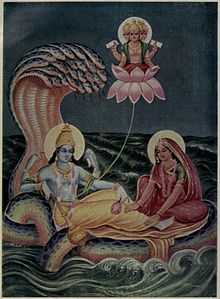Polycephaly
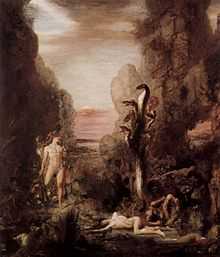
Polycephaly is a condition of having more than one head. The term is derived from the Greek stems poly- (Greek: "πολύ") meaning 'multiple' and kephali- (Greek: "κεφάλι") meaning "head", and encompasses dicephaly (or bicephaly, two-headedness). A variation is an animal born with two faces on a single head, a condition known as diprosopus. In medical terms these are all congenital cephalic disorders.
There are many occurrences of multi-headed animals, in real life as well as in mythology. In heraldry and vexillology, the double-headed eagle is a common symbol, though no such animal is known to have ever existed.
Bicephalic or tricephalic animals are the only type of multi-headed creatures seen in the real world and form by the same process as conjoined twins: they all result from the fusion of monozygotic twin embryos. One extreme example of this is the condition of craniopagus parasiticus, whereby a fully developed body has a parasitic twin head joined at the skull.
Occurrences
Two-headed people and animals, though rare, have long been known to exist and documented. The "Scottish brothers" were conjoined twins, allegedly dicephalic, born 1460 (dates vary). (Human conjoined twins, not all of the dicephalic type, have been documented since 945.)
Novelty and study
Polycephalic animals often make local news headlines when found. The most commonly observed two-headed animals are turtles and snakes.[1] Other species with known two-headed occurrences include cattle, sheep, pigs, cats, dogs, and fish. In 1894, a two-headed partridge was reported in Boston, Massachusetts.[2] It was notable as a dicephalic animal for surviving into adulthood with two perfect heads. Scientists have published in modern journals about dissecting such animals since at least the 1930s.[1] A 1929 paper studied the anatomy of a two-headed kitten.[1]
Polycephalic animals, due to their rarity, are a subject of novelty. "We", a two-headed albino rat snake born in captivity in 2000 with both female and male genitalia, was scheduled to be auctioned on eBay with an expected price tag of $150,000 (£87,000), though their policy of not trading in live animals prevented the sale.[3][4] On 31 October 2006, the World Aquarium[5] announced that "We" was adopted by Nutra Pharma Corporation, a biotechnology company developing treatments using modified cobra venom and cobratoxin.[6] "We" died of natural causes at age eight in June 2007, not long after being acquired by Nutra Pharma.[4]
Two-headed farm animals sometimes travel with animal side shows to county fairs. Most notably, The Venice Beach Freakshow supposedly houses the largest collection of two-headed specimens in the world, including over 20 two-headed animals that are alive. Many museums of natural history contain preserved two-headed animals. The Museum of Lausanne[7] in Lausanne, Switzerland, and the Ripley's Believe It Or Not! museum in Gatlinburg, Tennessee, have collections of preserved two-headed animals. A very well preserved 2-headed lamb is on display in Llanidloes museum in Wales. A live two-headed turtle named Janus can be seen at the Natural History Museum in Geneva, Switzerland.[8][9]
Anatomy and fitness
Each head of a polycephalic animal has its own brain, and they somehow share control of the organs and limbs, though the specific structure of the connections varies. Animals often move in a disoriented and dizzy fashion, with the brains "arguing" with each other; some animals simply zig-zag without getting anywhere[10] Snake heads may attack and even attempt to swallow each other. Thus, polycephalic animals survive poorly in the wild compared to normal monocephalic animals.
Most two-headed snakes only live for a few months, though some have been reported to live a full life and even reproduced with the offspring born normal. A two-headed black rat snake with separate throats and stomachs survived for 20 years. A two-headed albino rat snake named "We" survived in captivity for 8 years.[11] There is some speculation that the inbreeding of snakes in captivity increases the chances of a two-headed birth.[12]
A famous successful modern case is that of the human dicephalic twins Abigail and Brittany Hensel, born in 1990. The twins have two separate heads and faces; they each have their own individual brains, spinal cords, and hearts. Abby and Brittany, however, have four lungs, two stomachs, two gall bladders, and three kidneys (2 left, 1 right). Each twin controls the limbs and body parts on her "side", and with coordination that allows them to walk, run, play piano, swim, drive, and do anything else they wish.[13]
One or two animals?
It is difficult to draw the line between what is considered "one animal with two heads" or "two animals that share a body".
With humans, dicephalic conjoined twins such as Abigail and Brittany Hensel are considered "twins", i.e., two individuals.[14] This makes sense as there is a range of conjoinedness, and non-dicephalic conjoined twins may be barely conjoined and separable by surgery, as was the case with Chang and Eng Bunker. Although the Hensel twins only have one pair of arms and legs total, each twin controls one side of the body's limbs. On the other hand, Syafitri, born 2006 in Indonesia, were given one name by their parents because they only had one heart.[15] In early Germany, conjoined twins that could not be separated were legally considered a single entity.[16]
With other animals, polycephaly is usually described as "one animal with two heads".[3][17] One of the heads, especially in three-headed animals, may be poorly developed and malformed, and not "participate" much.[10]
Earliest known occurrence
The February 22, 2007 issue of the journal Biology Letters detailed the discovery of a 120 million-year-old fossil of a 2-headed Hyphalosaurus lingyuanensis, marking the earliest known occurrence of axial bifurcation.[18]
List of recent occurrences
Humans
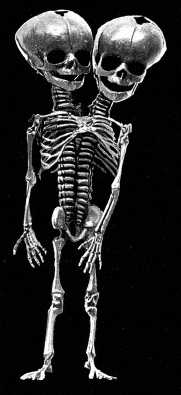
From: Hirst & Piersol, 1893.
Dicephalic conjoined twins (dicephalus dipus)
- In 1990 Abigail and Brittany Hensel were born in Minnesota, United States[13]
- In 2000 Ayse and Sema Tanrikulu were born in Kahramanmaraş, Turkey[19]
- On June 13, 2003, twin girls named Huda and Manal Abdel Nasser Mohammed Mahmoud, were born in Asyut, Egypt[20]
- In 2003 Sohna and Mohna were born in India[21]
- In 2006 Syafitri was born in Indonesia[15]
- In 2007 Mary Grace and Mary Divine Asis were born in the Philippines having only one heart.[22]
- On August 25, 2008 a baby boy named Kiron was born with two heads in south-western Bangladesh.[23] The baby was described by the gynaecologist present at the birth as having "one stomach and he is eating normally with his two mouths. He has one genital organ and a full set of limbs". He died three days later on August 28.[24]
- In July 2009 a pair of dicephalic twins were born in Indonesia with two hearts and sharing all other internal organs.[25]
- On December 19, 2011 a pair of male twins, Emanoel and Jesus Nazare, were born in Marajó Island, Brazil. The children had two heads, two legs and two arms, sharing all the body below the neck. Each child had a separate spine, but shared a heart, liver, lungs and pelvis, and both brains functioned. The boys appeared on the Channel 4 programme "Bodyshock" on 19 Dec 2012, where it was reported they had died at 6 months.[26][27]
- In 2011 Sueli Ferreira gave birth to a child with two heads in Campina in Paraiba state, Brazil, but the baby died a few hours later because of lack of oxygen to one of the heads.[27]
- In March 2014 dicephalic twin girls were delivered via caesarian section at Cygnus JK Hindu Hospital in Sonipat, Haryana, in northern India. The babies reportedly have two heads, two necks and two spinal columns but share all major organs.[28]
Craniopagus parasiticus
Craniopagus parasiticus is a condition in which a parasitic twin head with an undeveloped or underdeveloped body is attached to the head of a developed twin. Recorded cases include:
- In 1783 the "Two-Headed Boy of Bengal" was born in India; the second head was joined roughly upside down on top of the developed twin's head. The boy survived until 1787 and was killed by a snakebite.
- In 2003 Rebeca Martinez was born in the Dominican Republic with an extra head but died 7 hours after surgery at the age of 8 weeks.[29]
- In 2004 Egyptian Naglaa Mohamed gave birth to Manar Maged who had the head and undeveloped torso of another child attached. In 2005 the second head was removed and later that year Naglaa appeared on The Oprah Winfrey Show with her surviving child.[30] Manar died from a brain infection in 2006.[31]
Unconfirmed reports
- In 2008 a female child named Lali Singh was born to Vinod and Sushma Singh of the Gautam Buddha Nagar district of Uttar Pradesh in India.[32] The family has refused special medical care, and recent reports state that the case is not one of polycephaly, but a condition called craniofacial duplication, a rare congenital disorder.[33] The child later died from a heart attack.
Non-human mammals
Cats

There have been numerous reports of two-faced cats; most die soon after birth. Reports of two-headed kittens are common, relative to other animals, because of their status as household pets. Recent two-headed kittens include:
- On June 11, 2013, a two-faced kitten named Deucy was born in Amity, Oregon. She died two days later.
- In November 2008, a two-faced kitten was born in Perth, Australia.[34]
- In 2006, Tiger, a two-faced kitten, was born in Grove City, Ohio.[35]
- In March 2006, Deuce, a two-faced kitten, was born in Lake City, Florida, and was euthanized shortly thereafter, having come down with pneumonia.[36]
- In June 2006, Image, a two-faced kitten, was born on and died later that year in Philadelphia, Pennsylvania.[37][38]
- In June 2005, Gemini, a two-faced kitten, was born in Glide, Oregon.[39]
Polycephalic cats in museums include:
- The Museum of Lausanne in Lausanne, Switzerland, preserves a two-headed kitten (pictured).
- The Laing Museum in the small town of Newburgh, Fife, Scotland, preserves the stuffed body of a two-headed kitten born in the 19th century on Mugdrum Island.
- The Georgia State Capitol in Atlanta, Georgia, has a full body taxidermy of a two-faced kitten.
- Ripley's Believe It or Not! Museum on Clifton Hill in Niagara Falls, Ontario (Canada) has a full-body taxidermy of a two-faced kitten.
- Eton College's Natural History Museum has a full-body taxidermy of a 2-faced kitten.
Cattle
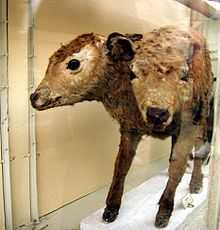
A full body taxidermy of a two-headed calf is on display at the Garth and Jerri Frehner Museum of Natural History on the Southern Utah University campus in Cedar City, Utah. "The Dancing Calves" were born by natural delivery with considerable assistance from S. T. Nelson of Cedar City, Utah on Mother's Day, May 8, 1949, to a crossbred cow owned by Willard Lund of Paragonah, Utah. The "Father Bull" is unknown but must have been an outstanding Hereford. The double calf was alive and healthy but died during birth. This calf, or calves, joined together from the beginning of the neck as far as the belly, with two complete, almost perfect body frames, had but one system of vital organs. Each of the two normal heads had a food channel to one stomach and a breathing channel, or windpipe, to the one set of lungs. The two briskets, or breasts, shared on each side by these calves, contained the one set of lungs on one side and the one heart on the other side. Branching off from the one stomach and digestive system were two channels of elimination. This calf weighed approximately 85 pounds at birth. The over-all measurements as it stands mounted are: 42.5 inches high, 20 inches from tail to tail, and 18 inches from side to side including the front legs. The "Mother Cow" lived and was sold as a "fat cow" in July, 1949. This calf was stuffed by Mr. C. J. Sanders, taxidermist, 2631 South State Street, Salt Lake City 5, Utah, who stated that it is the most unusual monstrosity he has ever worked with. Dr. A. C. Johnson, of Cedar City, Utah, stated that this is the best specimen of monstrosity in animal life that he has ever seen or heard of in his 47 years of practice as a veterinarian. "The Dancing Calves" were owned by West and Gail Seegmiller who displayed them for many years at their Desert Pearl Cafe (no longer in existence), in Cedar City, Utah. Dr. A. C. Johnson, Dr. T. Donald Bell, William H. Lund, Dr. R. G. Williams, Dr. J. S. Prestwich, Dr. A. L. Graff, S. T. Nelson, and James Hoyle, Jr. all signed as witnesses that they saw the calf in the flesh soon after birth and knew it to be authentic. The calves and original document were donated to the Garth and Jerri Frehner Museum of Natural History on the Southern Utah University campus in Cedar City, Utah, where they are now on display.
- A head mount of a two-headed calf is on display in the Museum at the Georgia State Capitol Building in Atlanta, Georgia.
- A two-faced calf is preserved at the Douglas County Museum in Waterville, Washington. The calf lived for ten days after birth.
- The Ripley's Believe It or Not! museum in Gatlinburg, Tennessee, has full body taxidermy of a two-headed calf.
- The Dalton Gang Museum, located in Meade, Kansas, also displays a full body taxidermy of a two-headed calf.
- A two-headed calf mount can be found at the Old State House in Hartford, Connecticut
- A two-headed calf was born in Frankston, Texas on February 13, 2009. Reportedly, the owner/rancher, J.R. Newman immediately took the calf to his local veterinarian for examination/treatment. The veterinarian, Dr. James Brown was quoted by a local reporter as saying, "I've seen slight variations [of this condition] but nothing like this before. This is by no means normal."[40]
- A full taxidermy of a two headed calf can be found in Melton Mowbray museum, Leicestershire, UK
- A full taxidermy of a two headed calf can be found in the Museum of Marxell (in the Northern Black Forest in Germany). The calf was born by a local cow and died shortly after birth by natural causes.
- A full taxidermy of a two-headed calf is on display at the Ohio Historical Society.
- A taxidermy of a two-headed calf was previously on display at Hereford Museum and Art Gallery.
- A full body taxidermy of a two headed calf can be seen at the Grant County Historical Museum in Canyon City, Oregon. A card next to the specimen states the heifer was born on the Bob Sprout ranch near Mt. Vernon, and that the calf had 2 hearts, lungs, and 2 spinal columns. Also at the museum are the mounted heads of two diprosopus (two-faced) calves.
- A full taxidermy of a two-headed calf is on display at the Haifa Zoo, in Haifa Israel.
- A Taxidermy specimen of a two headed calf can be seen at the Michigan State University museum in their Cabinet of Curiosities exhibit (not always available). the two-headed calf was born in Fowler, Mich. in 1943 and is often paired with a dwarf calf which was born on a farm in Owendale, Mich. in 1909.
- A full taxidermy of a two-headed calf can be seen advertising ice cream for Collage of the Ozarks in Branson,MO were it was delivered by the students.
Pigs

- A preserved two headed piglet can be seen at the Museum of Witchcraft, Boscastle, Cornwall, England.
- A two-headed piglet can be found at the Old State House in Hartford, Connecticut.
- In 1998, Rudy, a two-headed pig, was born in Iowa.[1]
- A two-headed piglet appeared on one episode of Oddities.
- A two-headed piglet was a display at the Stearns County Museum in St. Cloud, MN, until the mid-1970s, but cannot be confirmed; it may have been creative taxidermy.
Goats and sheep
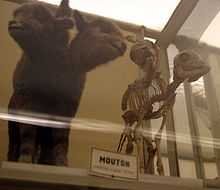
- In 2006, a two-headed lamb was born in Shandong, China.
- The Ripley's Believe It Or Not! museum in Gatlinburg, Tennessee, has a mount.
- The Llanidloes town museum in Powys, Wales has an example of a 2-headed lamb.
- The Liebig Extract of Meat Company factory (now a museum) in Fray Bentos, Uruguay, has a preserved 2-headed lamb.
Reptiles
Snakes
Most polycephalic snakes do not live long, but some captive individuals do.[41]
- A two-headed black rat snake with separate throats and stomachs survived for 20 years.[42]
- There are several preserved two-headed snakes on display in the Museum at the Georgia State Capitol Building in Atlanta.[43]
- A two-headed Boa constrictor was born in a pet shop in Hayward, California in May 2009. Owner Aaron Dickey decided to sell the snake to the Venice Beach Freak Show.[44]
- "We", the two-headed albino rat snake. See above.[4]
- A two-headed ladder snake, Elaphe scalaris, was discovered near the village of Pinoso, Spain.[12]
- A two-headed king snake lived for nearly 17 years at the Arizona State University.[42]
Turtles
Two-headed turtles and tortoises are rare but not unknown. Recent discoveries include:
- In 1999, a three-headed turtle was discovered in Tainan, Taiwan, by a villager named Lin Chi-fa.[1][10]
- In 2003, a two-headed angulate tortoise was discovered in South Africa, with the only other known case in the region reported in the early 1980s.[17]
- In 2004, Solomon and Sheba, a two-headed Mediterranean spur-thighed tortoise, was born in Dorchester, England.[45]
- In 2005, a two-headed Olive Ridley sea turtle was found in Costa Rica by the World Wildlife Fund.[46]
- In 2005, a baby turtle of unknown species was also reported in Havana, Cuba, in 2005.[47]
- In 2006, a two-headed, six-limbed soft-shell turtle in Singapore named "Double Happiness" was also featured on a local television program, and again on another program in late 2006.[48]
- As of September 2007, a ten-year-old living two-headed Greek Tortoise named Janus is being displayed in the Museum of Natural History of Geneva.[49][50]
- As of 2007, there is a fully preserved Common Snapping Turtle named Emily with two heads at the Science Museum of Minnesota.[51]
- In February 2011, a two-headed turtle was uncovered in Garner, North Carolina.[52]
- A two-headed Florida Redbelly Turtle named Gege lived at the Homosassa Springs Wildlife State Park, transferred to a zoo where it spent the rest of its natural life until summer of 2008.
- A two-headed turtle is currently on display at the Coex Aquarium in Seoul, South Korea.
- A two-headed turtle was released into the ocean with about 50 other turtles as part of a Broward County, Florida hatching turtle rescue program on July 19, 2012.
- A two-headed turtle named Thelma and Louise, was born at the San Antonio Zoo on June 18, 2013.[53]
Crocodiles
- There is a full body mount of a crocodile with two heads at the Georgia State Capitol on the top level.
Choristoderes
In 2006, the UK Royal Society announced that it had discovered a two-headed fossil of Hyphalosaurus, the first recorded time that such a reptile has been found fossilized.
Mythological occurrences
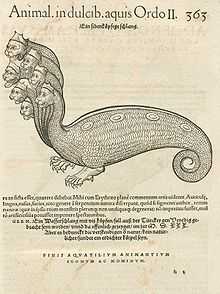
Mesopotamian mythology
- Mušmaḫḫu, a seven headed serpent related to mythology of Ninurta,[54] and Ningishzida.[55][56] Sometimes related to Mušḫuššu.
Greek mythology
Greek mythology contains a number of multi-headed creatures. Typhon, a vast grisly monster with a hundred heads and a hundred serpents issuing from his thighs, is often described as having several offspring with Echidna, a creature with the body of a serpent but the face of a beautiful woman. Their offspring account for all the major monsters of Greek mythos, including:
- Cerberus – a monstrous three-headed dog that guards the gate to Hades.
- Ladon – a sometimes hundred-headed serpentlike dragon that guards the garden of the Hesperides and is overcome by Heracles.
- Chimera – sometimes depicted with the heads of a goat and a lion
- The Lernaean Hydra – an ancient nameless serpent-like chthonic water beast that possessed numerous heads.
- Orthrus – a two-headed dog owned by Geryon.
- The Hecatonchires were giants with fifty heads and one hundred arms. The word "Hecatonchire" means "hundred arms". They were the sons of Gaia, and Uranus.
- Hecate - Greek goddess of witches, nightmares, crossroads, and one of the Moon deities; sometimes represented with three heads.
- Janus – Greek god of the doors, crossroads, and choices who had two heads to symbolize choices someone could make.
- Ayia Napa sea monster A Cryptid which according to legend lives off the coast of Ayia Napa Cyprus called φιλικό τέρας, Filiko Terras or friendly monster by locals.In illustrations it is represented to look like Scylla.
Other accounts state that some of these creatures were the offspring of Phorcys and Ceto. Phorcys is also said to have fathered Scylla, a giant monster with six dogs' heads, which terrorises Odysseus and his crew.
Hinduism
Hindu deities are often depicted with multiple arms and heads.
- The fire-god Agni has two heads
- Dattatreya: three
- The creator-god Brahma: four
- The goddess Gayatri: five
- The war-god Kartikeya: six
Though usually depicted with one head, some deities like Ganesha (in Heramba form) and Shiva (Sadashiva) have aspects where they are depicted with multiple heads; five in this case. The Vishvarupa form of Vishnu is described to have infinite heads.
Besides deities, demons (asura and rakshasa) may be depicted with multiple heads. The demon-king Ravana is depicted with ten heads; while his son Trishira with three heads.
Animal races in Hindu mythology like Nāgas (serpents) may have multiple heads. The Naga Shesha is depicted to have five or seven hoods, but described to have infinite hoods. Uchchaihshravas is a celestial seven-headed horse. The divine white elephant Airavata is depicted with multiple heads, trunks and tusks.
In Taoism
- Nezha, a goddess sometimes shown in "three heads and six arms" form
In Occultism
Ancient Mediterranean civilizations
- Janus, a two- or four-faced god in Roman mythology
- Nehebkau, a two-headed snake in Egyptian mythology
European culture
- Various Ogres, Trolls, and Giants in European folklore and fairy tales
- Double headed eagle, a heraldic symbol.
- Lernaean Hydra, Greek Mythology
Eastern Europe
- Balaur, a dragon with three, seven or twelve heads, in Romanian mythology
- Svantevit, four-headed god of war and divination in Slavic mythology
- Triglav (meaning "three headed") is a god or complex of gods in Slavic mythology
- Zmey Gorynych, a dragon in Slavic mythology
- Dragons in Hungarian folklore usually have three or seven heads
Northern Europe
- Þrúðgelmir, a six-headed giant in Norse mythology
Japan
- Yamata no Orochi, an eight-headed snake in Japanese mythology
Heraldry
Modern fiction
The following are possible examples of polycephaly in modern fiction.
- In Percy Jackson and the Olympians, Percy and his companions sight a hydra. They also have multiple encounters with Cerberus, the mythical three-headed dog who guards the underworld in Greek mythology.
- Angels in the TV series Supernatural have triple heads, one human, and the other two representing different animals. This is one reason they possess humans to act on Earth.
- Zaphod Beeblebrox, in the Hitchhiker's Guide to the Galaxy
- Joe-Jim, from Robert A. Heinlein's Orphans of the Sky, is a mutant case of dicephalic conjoined twins.
- Various Yu-Gi-Oh monsters have three heads, most notably, the Blue-Eyes Ultimate Dragon.
- A Two Headed Shark is the main antagonist of the 2012 film, 2-Headed Shark Attack and also one of the Asylum monsters.
- Magic: The Gathering has Hydras and sporadically features various creatures with multiple (particularly two) heads since Limited Edition Alpha like Two-Headed Giant of Foriys, which has also a multiplayer format named after it, implying that two players team up against two other players. Further cards include Two-Headed Dragon, Two-Headed Sliver and also Double Header, which could be regarded as a parody of such creatures.
- In Anthony Horowitz's novels Groosham Grange and Return to Groosham Grange, the headmasters of Groosham Grange have two heads (this is a play on the word "heads" used when more than one headmaster are present). The headmasters are named Mr Fitch and Mr Teagle. The reason for them being polycephalic is because they were once two normal black magicians but one of their dangerous experiments went wrong, combining their bodies. However they still have their personalities and can be rather humorous at times, sometimes talking to each other at night. The worst thing they can suffer is a headache.
- Troigs from the Star Wars universe
- Various Pokémon, including Doduo (two heads), Dodrio (three heads), Exeggutor (three or more heads), Girafarig (two heads), Zweilous (two heads) and Hydreigon (three heads with two lacking brains). Dugtrio is often cited as having three heads, although it may as well be a colony of three animals.
- Gleeok, from The Legend of Zelda is a multi-headed dragon, with his number of heads depending on his occurrence. It appears in the Legend of Zelda (two heads in level 4, three heads in level 6, and four heads in level 8), Oracle of Seasons (two heads), and Phantom Hourglass (two heads). Trinexx, from A Link to the Past has 3 heads.
- The Red Etin, three-headed giant of Scottish folklore.
- The Three-Headed Giant in Monty Python and the Holy Grail.
- Fluffy, a gigantic three-headed dog in the novel Harry Potter and the Philosopher's Stone. The dog is based on Cerberus.
- King Ghidorah, the evil dragon king in the Godzilla franchise and Godzilla's arch enemy.
- Tryclyde, the three-headed snake enemy from the video game Super Mario Bros. 2.
- In the third episode of the sixth production season of Futurama a two-headed goat with heads on opposite sides of the body is shown puking one end and vomiting diarrhea the other.
- Linda-Louise Carney, a comic book character, who's a two-headed, teenage circus freak and part of the cast from Archie Comics' The Carneys. She also appeared on a cover of a different comic book series known as Dumb-Ass Express.[57]
- Devon and Cornwall, a two-headed dragon character from the Warner Bros. animated film Quest for Camelot.
- Rose and Ruby Darlen, craniopagus parasitic twins in the novel The Girls, their fictional autobiography told from alternating viewpoints as they approach their thirtieth birthday, making them the world's oldest craniopagus twins.
- The Pushmi-pullyu from the Doctor Dolittle books by Hugh Lofting.
- In the Fallout series there are 2-headed cows known in-game as "Brahmin."
- Also in the Fallout series, the flag of the fictional New California Republic is the same bear flag as California has in the real world, except the bear has two heads.
- Zak and Wheezie from Dragon Tales.
- CatDog has the head of a cat and dog, from the series bearing the same name as the character.
- The Two-Headed Monster on Sesame Street.
- The film adaptation of How to Train Your Dragon features a species of 2-headed dragon called hideous zipplebacks, based on the 8-headed Greek Hydra.
- The film The X-Files: I Want To Believe features a two-headed dog, along with a plot involving a human head transplant.
- World of Warcraft also has many two-headed creatures, some are killable and others help the player with quests.
- The Wither in the video game Minecraft has three heads.
- Terri and Terry Perry from the movie Monsters University. There is also a two-headed pigeon-like monster at the beginning of the film.
- May-Jim, a two-headed frog spirit from The Legend of Korra.
- Before the Ninth Doctor regenerates, he mentions having two heads.[58]
- A boss in the video game The Binding of Isaac: Rebirth, named Polycephalus, appears as a large buried head with a collection of heads sprouting from it. This boss is also named after Polycephaly.
See also
- Conjoined twins
- Janus
- Chimera
- Amphisbaena
- Cephalic disorder
- Diprosopus
- Krista and Tatiana Hogan
- Supernumerary body part
- Vladimir Demikhov
References
- ↑ 1.0 1.1 1.2 1.3 1.4 Anina, Svetlana (2003-11-29). "Two-Headed Creatures". Pravda.ru. Retrieved 2006-12-31.
- ↑ "A two-headed partridge". The Washington Post. 1894-05-06. Retrieved 2006-12-31.
- ↑ 3.0 3.1 "Two-headed snake 'up for auction'". BBC News. 2006-01-03. Retrieved 2006-03-10.
- ↑ 4.0 4.1 4.2 "'We' the 2-headed snake's long odd life ends". MSNBC. Retrieved 2007-06-20.
- ↑ "World Aquarium". Retrieved 2006-12-31.
- ↑ "Nutra Pharma Adopts Famous 2-Headed Snake of St. Louis’ World Aquarium".
- ↑ "Le Musée cantonal de Géologie (The Museum of Lausanne)". Retrieved 2006-12-31.
- ↑ "Janus, live two-headed turtle". Euphoia Magazine. 23 April 2008. Retrieved 2011-05-13.
- ↑ "Plan des galeries publiques" [Plan of the public galleries] (in French). Retrieved 2011-05-13.
- ↑ 10.0 10.1 10.2 "Three-headed turtle destined not to go far". Associated Press. 1999-01-27. Retrieved 2006-12-31.
- ↑ "'We' the 2-headed snake's long life ends".
- ↑ 12.0 12.1 Mayell, Hillary (March 22, 2002). "Life Is Confusing For Two-Headed Snakes". National Geographic News. Retrieved 2006-03-10.
- ↑ 13.0 13.1 Chang, Maria L. (1996-10-04). "Joined for life - co-joined six-year-old Hensel twins share many body parts". Science World. Retrieved 2006-12-31.
- ↑ Wallis, Claudia (1996-03-25). "The most intimate bond: Conjoined for life, the Hensel twins are a medical mystery and a lesson in cooperation for us all". Time magazine. Retrieved 2006-12-31.
- ↑ 15.0 15.1 "Conjoined twins still a mystery". The Jakarta Post. 2006-08-26. Retrieved 2006-12-31.
- ↑ Bondeson, Jan (2004). The Two-headed Boy, and Other Medical Marvels. Cornell University Press. ISBN 978-0801489587.
- ↑ 17.0 17.1 Swarts, Candice (2003-05-30). "Rare Two-Headed Tortoise Found in South Africa". National Geographic News. Retrieved 2006-03-10.
- ↑ "Ancient Reptile Has Two Heads".
- ↑ "Conjoined twins' first steps (In Turkish)". Radikal. Retrieved 2008-11-04.
- ↑ Flannigan, Ozryel (2003-06-13). "Egyptian mummy gives birth to two-headed girl". IOL: News for South Africa and the World. Retrieved 2008-11-12.
- ↑ Rana, Yudhvir (2004-06-05). "Bound by destiny, life may be a bind for them". Times of India. Retrieved 2006-12-31.
- ↑ "Doctors vow to save dicephalus twins from death". GulfNews. 2007-04-24. Retrieved 2007-04-26.
- ↑ "Two-headed baby born in Bangladesh". The Sydney Morning Herald. August 28, 2008. Retrieved August 28, 2008.
- ↑ "A baby boy born with two heads has died after developing a fever and breathing difficulties, a Bangladeshi doctor says.". Sky News. August 28, 2008. Retrieved August 28, 2008.
- ↑ "Conjoined twins born with one body". CNN. 2009-07-26. Retrieved 2009-07-26.
- ↑ Pfeiffer, Eric (2011-11-15). "Healthy two-headed baby born in Brazil | The Sideshow - Yahoo! News". News.yahoo.com. Retrieved 2012-05-02.
- ↑ 27.0 27.1 "Brazilian Baby Born With 2 Heads". Foxnews.com. 2010-04-07. Retrieved 2012-05-02.
- ↑ Hodgekiss, Anna (2014-03-13). "The baby with two heads: Indian mother too poor to have an ultrasound gives birth to conjoined twins". Daily Mail (London). Retrieved 2014-03-17.
- ↑ "Two-Headed Baby Dies After Surgery". CBS News. 2004-02-07. Retrieved 2007-02-08.
- ↑ "It's a Miracle! The Two-Headed Baby!". 2005-05-19. Retrieved 2007-02-08.
- ↑ "Doctors unable to save two-headed girl". 2006-03-27. Retrieved 2008-08-18.
- ↑ Wilson, Sam (2008-03-18). "Indian woman gives birth to 'miracle' child". London: Telegraph. Retrieved 2008-03-18.
- ↑ "India two-faced baby's family refuses special care". Reuters. 2008-04-10. Retrieved 2008-04-10.
- ↑ "Two-faced kitten born in Perth". 2008-11-19. Retrieved 2008-11-19.
- ↑ "Kitten Born With Two Faces, One Body". NBC6 South Florida. 2006-07-17. Retrieved 2006-12-31.
- ↑ "Kitten Born With Two Faces". newsnet5. 2005-03-10. Retrieved 2006-12-31.
- ↑ "Two-Faced Kittens". 2000-06-07. Retrieved 2006-03-10.
- ↑ Gomez, Nicole (2000-06-10). "Two-Faced Kitten Has Image Problem". Retrieved 2006-12-31.
- ↑ Traylor, Dan (2005-06-16). "Two-faced kitten shocks owner, veterinarian". The News-Review. Retrieved 2006-12-31.
- ↑ "Rare two-headed calf born on Friday 13th". The Frankston Citizen 99 (31): 1. February 19, 2009.
- ↑ "Life Is Confusing For Two-Headed Snakes". News.nationalgeographic.com. 2010-10-28. Retrieved 2011-09-19.
- ↑ 42.0 42.1 "Life Is Confusing For Two-Headed Snakes". News.nationalgeographic.com. 2010-10-28. Retrieved 2011-09-19.
- ↑ "Georgia Capitol Museum". AOL Cityguide. Retrieved 2006-03-10.
- ↑ Two-Headed Snake&Nbsp;Born (2009-06-17). "TWO-HEADED SNAKE BORN | Weekly World News". Weeklyworldnews.com. Retrieved 2011-09-19.
- ↑ "Shell shock at two-headed tortoise". BBC News. 2004-11-12. Retrieved 2006-12-31.
- ↑ "Two-headed turtle found in Costa Rica". 999Today. 2005-12-01. Archived from the original on 2006-06-24. Retrieved 2013-06-30.
- ↑ "Two-headed turtle found in Havana, Cuba". mongabay.com. 2005-10-01. Retrieved 2006-03-10.
- ↑ "The Chinese Garden (Yu Hwa Yuan)".
- ↑ "Culture in Geneva". Retrieved 2006-03-10.
- ↑ "Getty Images". Getty Images. 2007-09-05. Retrieved 2012-05-02.
- ↑ "Science Museum of Minnesota - Collections Gallery". Smm.org. Retrieved 2012-05-02.
- ↑ "Two-headed turtle found in Garner". WRAL.com. 2001-09-11. Retrieved 2011-09-19.
- ↑ "Two-headed Turtle, 'Thelma And Louise', Hatches At San Antonio Zoo". Huffington Post. 2013-06-26. Retrieved 2013-06-26.
- ↑ Cuneiform Monographs 1: Mesopotamian Protective Spirits, The ritual texts. F.A.M. Wiggermann p. 164
- ↑ http://etcsl.orinst.ox.ac.uk/cgi-bin/etcsl.cgi?text=t.4.19.2#
- ↑ http://etcsl.orinst.ox.ac.uk/cgi-bin/etcsl.cgi?text=c.4.19.2&display=Crit&charenc=gcirc#
- ↑ Offenberger, Rik. "Dan Parent: Making Betty & Veronica Spectacular". Comics Bulletin. Retrieved 2010-11-26.
- ↑ Davies, Russell T; Eccleston, Christopher (18 June 2005). "The Parting of the Ways". Doctor Who. Series 1. Episode 13. The Doctor Who Transcripts - The Parting of the Ways. BBC.
The Doctor: I might never make sense again. I might have two heads, or no head! [laughing] Imagine me with no head. And don't say that's an improvement.
External links
| Wikinews has related news: We, the two-headed snake, dies in U.S. museum at age 8 |
| Wikimedia Commons has media related to Double-headed animals. |
- "Two-headed animals going on show" at Newsround Online (accessed August 24, 2006).
- Video of two-headed piglet.
